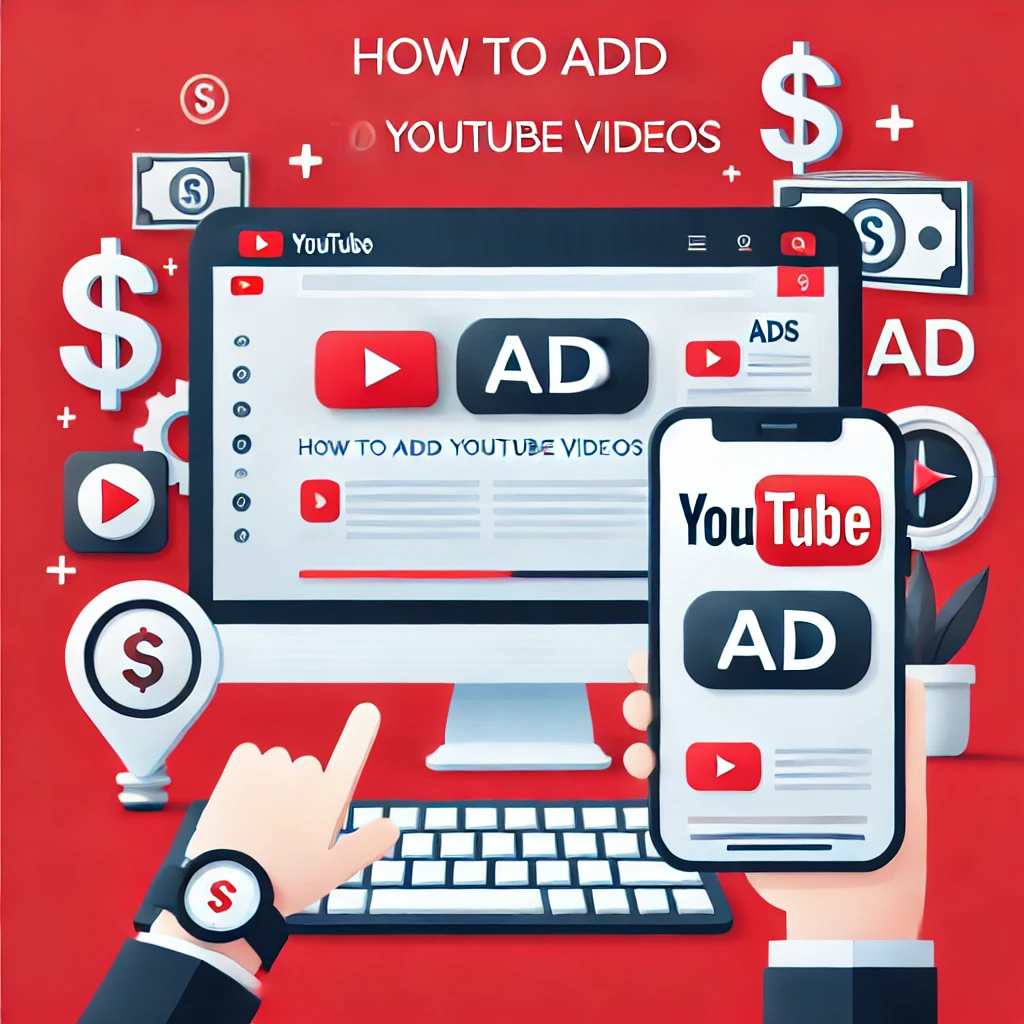Adding ads to your YouTube videos is a great way to monetize your content and start earning revenue from your channel. Once you qualify for YouTube’s Partner Program, you can enable ads and customize how and when they appear in your videos. In this guide, we’ll walk you through the steps to add ads to your YouTube videos, the different types of ads available, and tips for maximizing ad revenue.
Table of Contents:
- Why Add Ads to Your YouTube Videos?
- How to Qualify for YouTube Monetization
- Types of Ads on YouTube
- How to Add Ads to Your YouTube Videos
- Tips for Maximizing Ad Revenue on YouTube
- FAQs About YouTube Ads
1. Why Add Ads to Your YouTube Videos?
Adding ads to your YouTube videos is the primary way many creators earn money on the platform. Here’s why you should consider adding ads to your content:
- Earn Passive Income: Once ads are placed on your videos, you can earn money while viewers watch them.
- Monetize Popular Videos: If your videos get a lot of views, you can earn significant revenue through ads.
- Support Your Channel’s Growth: Ad revenue can help fund better equipment, editing software, and other resources to improve the quality of your content.
2. How to Qualify for YouTube Monetization
Before you can add ads to your YouTube videos, you need to qualify for the YouTube Partner Program (YPP). To be eligible for monetization, your channel must meet the following criteria:
- 1,000 subscribers
- 4,000 watch hours over the last 12 months
- Comply with YouTube’s policies and community guidelines
- Have an AdSense account linked to your YouTube channel
Once you meet these requirements, you can apply for the YouTube Partner Program. If accepted, you’ll be able to monetize your videos and start earning ad revenue.
3. Types of Ads on YouTube
YouTube offers several types of ads that can appear before, during, or after your videos. Understanding these ad types will help you decide which ones to enable for your content.
1. Skippable Video Ads
These ads can be skipped after 5 seconds by viewers. They are typically shown before or during the video, and creators earn money when viewers watch the ad for at least 30 seconds or click on it.
2. Non-Skippable Video Ads
Non-skippable ads must be watched in full before the video begins. They are usually 15-20 seconds long, and creators earn money for each impression (view).
3. Bumper Ads
Bumper ads are short, non-skippable ads that last up to 6 seconds. They appear before the video and are designed to capture viewers’ attention quickly.
4. Display Ads
Display ads appear next to the video on the right-hand sidebar. They are typically small banner ads that don’t interrupt the video content.
5. Overlay Ads
Overlay ads are semi-transparent ads that appear at the bottom of the video. They only appear on desktop devices and can be closed by viewers.
4. How to Add Ads to Your YouTube Videos
Once you’re accepted into the YouTube Partner Program, adding ads to your videos is simple. Here’s a step-by-step guide:
Step 1: Sign In to YouTube Studio
Go to YouTube Studio and sign in with your YouTube account.
Step 2: Enable Monetization
In the left-hand menu, click on Content to see all your uploaded videos. Select the video you want to monetize, and click on the Monetization tab. Toggle the switch to enable ads for the video.
Step 3: Select Ad Formats
Once monetization is enabled, you can choose the types of ads you want to show. You can select from skippable ads, non-skippable ads, display ads, overlay ads, and bumper ads. You can enable multiple ad types to maximize revenue.
Step 4: Choose Ad Placement
If your video is longer than 8 minutes, you can place mid-roll ads at specific intervals throughout the video. You can either let YouTube automatically place ads or manually select where they should appear by clicking on Manage Mid-Roll Ads and dragging the markers to your desired spots.
Step 5: Save Changes
After selecting your ad preferences and placements, click Save to apply the changes. Ads will now appear on the video when viewers watch it.
5. Tips for Maximizing Ad Revenue on YouTube
Here are some strategies to help you maximize your YouTube ad revenue:
1. Create Longer Videos
Videos longer than 8 minutes allow you to insert mid-roll ads, increasing the number of ad impressions and boosting revenue. However, make sure your content remains engaging to avoid losing viewers.
2. Focus on High-CPM Niches
Some niches, like finance, technology, and education, tend to have higher CPM (Cost Per Mille) rates, meaning advertisers pay more to show ads on videos in these categories. If possible, create content within these niches to increase your earnings.
3. Maintain High Viewer Engagement
The more engaged your audience is, the more likely they are to watch or interact with ads. Focus on creating valuable and interesting content that encourages viewers to watch the entire video.
4. Use Analytics to Optimize Ad Placement
YouTube Analytics provides data on where viewers are dropping off during your videos. Use this information to optimize your ad placement and ensure ads are placed at points where viewer retention is high.
5. Diversify Your Revenue Streams
In addition to ads, consider other monetization options like Channel Memberships, Super Chat, and YouTube Premium revenue to further increase your earnings.
6. FAQs About YouTube Ads
Q: How much money do YouTubers make from ads?
A: YouTube ad earnings vary depending on factors like CPM rates, video length, and viewer engagement. On average, creators earn between $0.25 to $4 per 1,000 views. However, this can vary greatly depending on your audience and niche.
Q: Can I control where ads appear on my videos?
A: Yes, if your video is longer than 8 minutes, you can manually place mid-roll ads at specific points. For shorter videos, YouTube automatically places ads at the beginning or end of the video.
Q: Will ads negatively affect my video’s performance?
A: Too many ads can potentially drive viewers away, especially if they find the ads intrusive. Be mindful of ad placement, and ensure it doesn’t disrupt the viewer’s experience.
Q: Do all YouTube videos qualify for monetization?
A: No, not all videos are eligible for monetization. Your content must comply with YouTube’s community guidelines, copyright rules, and advertiser-friendly content policies to qualify.
Conclusion
Adding ads to your YouTube videos is a powerful way to monetize your content and generate passive income. By understanding how ads work, enabling the right ad formats, and strategically placing mid-roll ads, you can maximize your revenue and grow your channel’s earnings. Follow the steps in this guide to start monetizing your YouTube videos and make the most of YouTube’s Partner Program.

